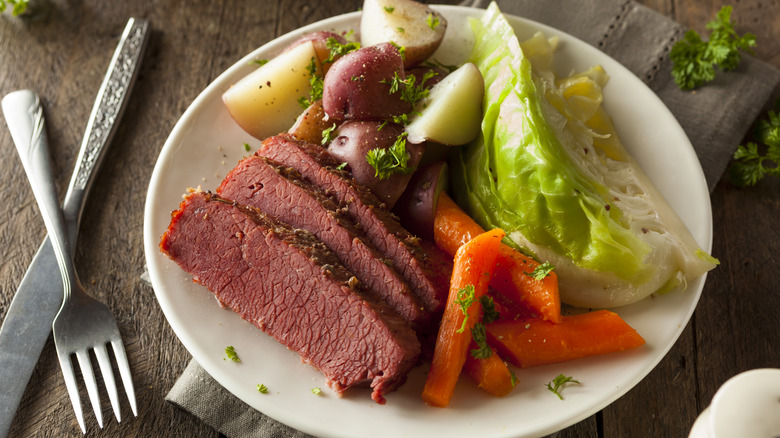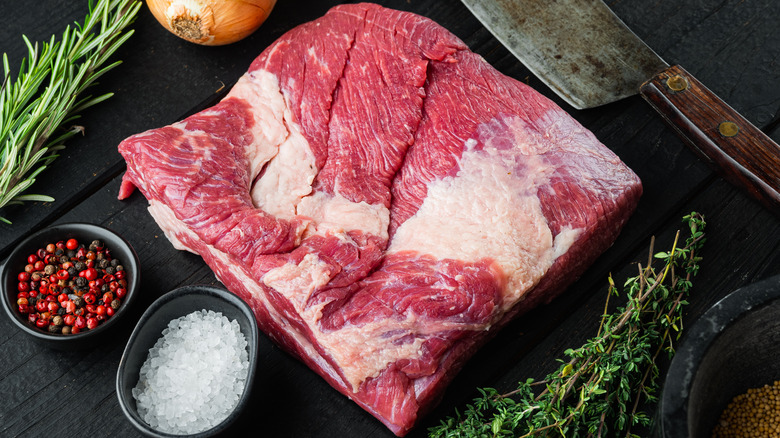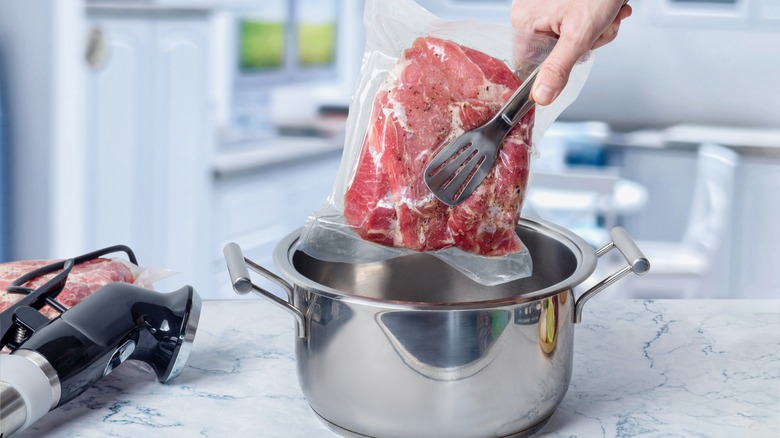How To Set Up A Perfect Low-And-Slow Simmer For Corned Beef
It might not be a truly Irish dish, but corned beef is an Irish-American classic. For hundreds of years, cattle weren't raised on Irish-owned farms for Irish consumption. Cows are resource-intensive stock and require a lot of good, fertile, green land (which was largely taken by the English). The cattle raised in Ireland were almost all exported, but The Cattle Acts of the 1600s prohibited the import of live cattle to England. At the time, the salt tax in Ireland was 10% of what it was in England. A method called corning, named after large salt grains about the size of corn kernels, was used to preserve the meat for export.
Irish Americans took this knowledge and skill with them to America, where beef was affordable and accessible to them. Settling in areas near Jewish neighborhoods, where beef was being made into pastrami in a related method, Irish immigrants began reclaiming corned beef for themselves.
Over time, corned beef's association with the Irish boiled dinner and Saint Patrick's Day has become a tradition in America. If you want your corned beef to actually be a delicious, melt-in-your-mouth tender dish, though, there's one hard and fast rule to making it: don't boil it.
The key to tender corned beef
A brisket is made up of muscle fiber, fat, and quite a lot of connective tissue. Because of all that connective tissue, it's not particularly tender without a bit of finessing. J. Kenji Lopez-Alt finessed 38 pounds of corned brisket for Serious Eats and learned a lot of important things about how temperature and cooking time affect the beef.
There are two potentially devastating outcomes to mistreating corned beef: it comes out tough, and/or it comes out dry. Connective tissue is primarily collagen, which is very strong. The key to tenderizing it is to melt down that collagen, which takes time. The sweet spot for beef is an internal temperature between 120 degrees Fahrenheit (rare) and 155 degrees Fahrenheit (well done). Once it hits 150 degrees Fahrenheit, though, the beef starts to dry out, leaving it unpleasant to eat in most applications.
Lopez-Alt noticed that the collagen adequately dissolved in 160-degree Fahrenheit cooking liquid after a whopping 36 hours, and it retained the most moisture in the finished beef at that temperature. At a 205-degree Fahrenheit cooking temp, it only took three hours but saw a 53% moisture loss.
Personal preference, time, and available equipment will largely dictate your cooking method and temperature. Lopez-Alt found that eight hours at 180 degrees Fahrenheit was his favorite, which can be achieved in multiple ways.
4 methods for cooking the best corned beef
The fanciest method for achieving tender, juicy corned beef is sous vide, which controls the cooking temperature and requires low attention. The downside? You're missing out on the highly flavored water to boil potatoes with this process since the meat is cooked separately. Anova Culinary recommends 48 hours at 140 degrees Fahrenheit for 2 pounds of beef.
A stovetop simmer is great for a tighter timeline. Water simmers between 185 and 205 degrees Fahrenheit. J. Kenji Lopez-Alt found that a simmer at around 190 degrees Fahrenheit took about six hours, whereas the high end of a simmer only took three. It came out a little drier at 205 degrees Fahrenheit, but not tough and horribly dry as it would be when boiled.
You can also simmer it in the oven. Place the corned beef in a Dutch oven and cover it in a few inches of water. Cook with the lid cracked; setting the oven at 200 degrees Fahrenheit will keep the water at approximately 180 degrees, which will yield nicely-textured corned beef in around 10 hours.
The happiest medium is our old friend, the slow cooker. Most slow cookers' "keep warm" setting maintains a temperature between 170 degrees and 180 degrees Fahrenheit and you can generally leave it unattended for the requisite 10 to 20 hours required for cooking. Just don't forget to monitor the liquid levels in your slow cooker, as overfilling can be a hazard and underfilling won't cook the meat properly.


